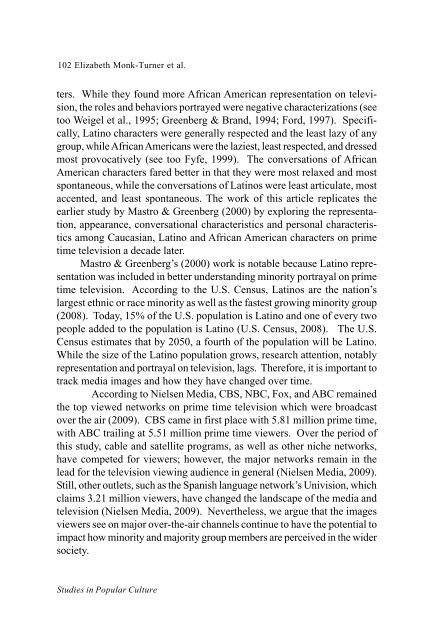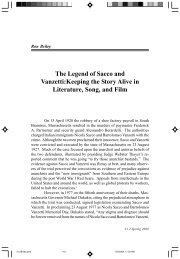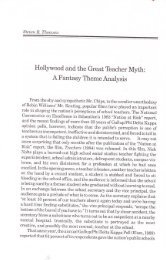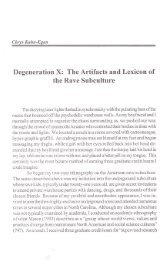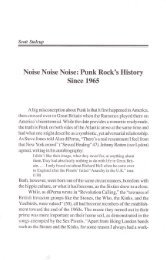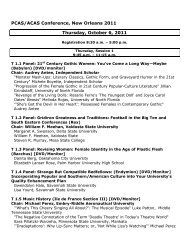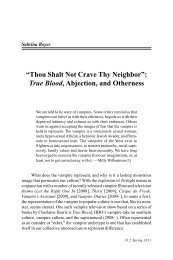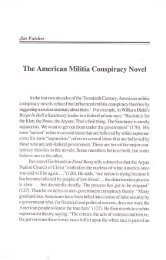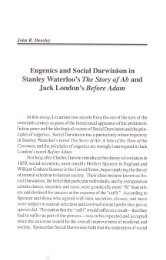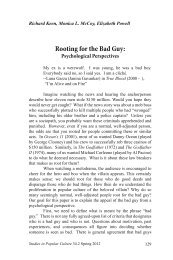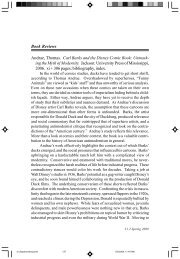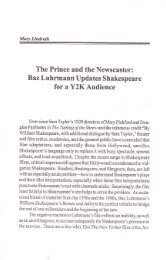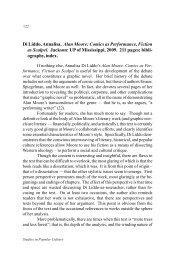The Portrayal of Racial Minorities on Prime Time Television: A ...
The Portrayal of Racial Minorities on Prime Time Television: A ...
The Portrayal of Racial Minorities on Prime Time Television: A ...
Create successful ePaper yourself
Turn your PDF publications into a flip-book with our unique Google optimized e-Paper software.
102 Elizabeth M<strong>on</strong>k-Turner et al.<br />
ters. While they found more African American representati<strong>on</strong> <strong>on</strong> televisi<strong>on</strong>,<br />
the roles and behaviors portrayed were negative characterizati<strong>on</strong>s (see<br />
too Weigel et al., 1995; Greenberg & Brand, 1994; Ford, 1997). Specifically,<br />
Latino characters were generally respected and the least lazy <str<strong>on</strong>g>of</str<strong>on</strong>g> any<br />
group, while African Americans were the laziest, least respected, and dressed<br />
most provocatively (see too Fyfe, 1999). <str<strong>on</strong>g>The</str<strong>on</strong>g> c<strong>on</strong>versati<strong>on</strong>s <str<strong>on</strong>g>of</str<strong>on</strong>g> African<br />
American characters fared better in that they were most relaxed and most<br />
sp<strong>on</strong>taneous, while the c<strong>on</strong>versati<strong>on</strong>s <str<strong>on</strong>g>of</str<strong>on</strong>g> Latinos were least articulate, most<br />
accented, and least sp<strong>on</strong>taneous. <str<strong>on</strong>g>The</str<strong>on</strong>g> work <str<strong>on</strong>g>of</str<strong>on</strong>g> this article replicates the<br />
earlier study by Mastro & Greenberg (2000) by exploring the representati<strong>on</strong>,<br />
appearance, c<strong>on</strong>versati<strong>on</strong>al characteristics and pers<strong>on</strong>al characteristics<br />
am<strong>on</strong>g Caucasian, Latino and African American characters <strong>on</strong> prime<br />
time televisi<strong>on</strong> a decade later.<br />
Mastro & Greenberg’s (2000) work is notable because Latino representati<strong>on</strong><br />
was included in better understanding minority portrayal <strong>on</strong> prime<br />
time televisi<strong>on</strong>. According to the U.S. Census, Latinos are the nati<strong>on</strong>’s<br />
largest ethnic or race minority as well as the fastest growing minority group<br />
(2008). Today, 15% <str<strong>on</strong>g>of</str<strong>on</strong>g> the U.S. populati<strong>on</strong> is Latino and <strong>on</strong>e <str<strong>on</strong>g>of</str<strong>on</strong>g> every two<br />
people added to the populati<strong>on</strong> is Latino (U.S. Census, 2008). <str<strong>on</strong>g>The</str<strong>on</strong>g> U.S.<br />
Census estimates that by 2050, a fourth <str<strong>on</strong>g>of</str<strong>on</strong>g> the populati<strong>on</strong> will be Latino.<br />
While the size <str<strong>on</strong>g>of</str<strong>on</strong>g> the Latino populati<strong>on</strong> grows, research attenti<strong>on</strong>, notably<br />
representati<strong>on</strong> and portrayal <strong>on</strong> televisi<strong>on</strong>, lags. <str<strong>on</strong>g>The</str<strong>on</strong>g>refore, it is important to<br />
track media images and how they have changed over time.<br />
According to Nielsen Media, CBS, NBC, Fox, and ABC remained<br />
the top viewed networks <strong>on</strong> prime time televisi<strong>on</strong> which were broadcast<br />
over the air (2009). CBS came in first place with 5.81 milli<strong>on</strong> prime time,<br />
with ABC trailing at 5.51 milli<strong>on</strong> prime time viewers. Over the period <str<strong>on</strong>g>of</str<strong>on</strong>g><br />
this study, cable and satellite programs, as well as other niche networks,<br />
have competed for viewers; however, the major networks remain in the<br />
lead for the televisi<strong>on</strong> viewing audience in general (Nielsen Media, 2009).<br />
Still, other outlets, such as the Spanish language network’s Univisi<strong>on</strong>, which<br />
claims 3.21 milli<strong>on</strong> viewers, have changed the landscape <str<strong>on</strong>g>of</str<strong>on</strong>g> the media and<br />
televisi<strong>on</strong> (Nielsen Media, 2009). Nevertheless, we argue that the images<br />
viewers see <strong>on</strong> major over-the-air channels c<strong>on</strong>tinue to have the potential to<br />
impact how minority and majority group members are perceived in the wider<br />
society.<br />
Studies in Popular Culture


